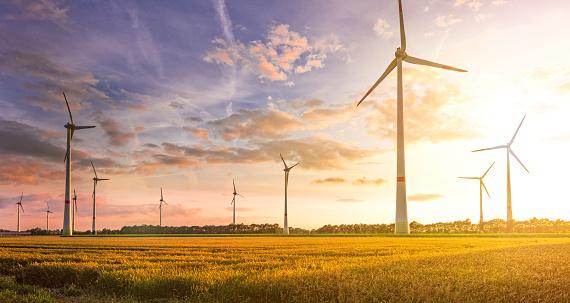Editor-in-Chief
- FMA
- The Fabricator
- FABTECH
- Canadian Metalworking
Categories
- Additive Manufacturing
- Aluminum Welding
- Arc Welding
- Assembly and Joining
- Automation and Robotics
- Bending and Forming
- Consumables
- Cutting and Weld Prep
- Electric Vehicles
- En Español
- Finishing
- Hydroforming
- Laser Cutting
- Laser Welding
- Machining
- Manufacturing Software
- Materials Handling
- Metals/Materials
- Oxyfuel Cutting
- Plasma Cutting
- Power Tools
- Punching and Other Holemaking
- Roll Forming
- Safety
- Sawing
- Shearing
- Shop Management
- Testing and Measuring
- Tube and Pipe Fabrication
- Tube and Pipe Production
- Waterjet Cutting
Industry Directory
Webcasts
Podcasts
FAB 40
Advertise
Subscribe
Account Login
Search
Can metal fabricators prosper with wind power?
Fab shops see opportunity with the continued push for renewable energy sources
- By Dan Davis
- March 17, 2021

The renewable energy markets, which include wind turbines, remain a viable industry sector for metal fabricators looking for new opportunities. Getty Images
The winter storms that hit Texas were no laughing matter. The ice and deep freeze caused the state’s power grid to collapse, and people suffered greatly. At least 57 people died as a result of the winter storm, mostly from hypothermia.
Unfortunately during this time, social media was here to confuse and misinform the masses about the power failure. In a state inextricably linked to the fossil fuel industry, memes were flying around blaming renewable energy sources for failing with the cold weather. The meme that comes to mind is a wind tower with icicles hanging from it and that’s not spinning, suggesting that it froze. Well, some wind turbines might have froze, but so did natural gas wells. In fact, some news outlets reported that nearly half of the state’s natural gas production went offline because of the extremely low temperatures. This wasn’t about faulty sources of energy; it was about Texas energy officials not investing in cold-weather systems that can operate below freezing temperatures.
Such misinformation could detail what many consider to be a nascent industry, but wind power is beyond that point. The push for more renewable sources of energy is sure to continue. Many will be amazed to know that Texas is the dominant power in wind energy production in the U.S. with a total installed capacity of 28,843 megawatts in 2019.
U.S. wind electricity accounted for 300 billion kilowatt-hours in 2019, which is triple what it was in 2010. With states such as California lobbying for energy to be produced completely from renewable sources, wind power is going to be a key market for years to come. Fabricators should make note of that.
Shops that can roll the “cans” that make up the towers that support wind turbines are few and far between. They have to have the equipment to roll plate to diameters that can reach just over 16 ft. for wind towers found onshore and 25 ft. for those offshore. These shops also require the expertise to meet customer-specified dimensions or risk scrapping expensive plate. Was it mentioned that some of these tower sections require conical bends and angle differentiation as the cans are stacked from the bottom section up? Fabricating these wind tower components is not easy job, but it can be lucrative for the metal fabricating company that specializes in heavy-duty work.
For those interested in learning more about what it takes to fabricate components for the wind turbine industry, consider attending this webinar sponsored by Faccin, a manufacturer of plate and angle rolling machines. The webinar—“Wind Industry Manufacturing Overview: Solutions Today to the Challenges of the Future”—is scheduled for April 8 and covers the latest market data on the wind power market, future challenges facing the industry, and discussion on the latest technologies available to help fabricators become a part of the wind power supply chain.
Fabricating companies looking to take advantage of new market opportunities don’t want to be frozen out of this energy sector.
subscribe now

The Fabricator is North America's leading magazine for the metal forming and fabricating industry. The magazine delivers the news, technical articles, and case histories that enable fabricators to do their jobs more efficiently. The Fabricator has served the industry since 1970.
start your free subscriptionAbout the Author

Dan Davis
2135 Point Blvd.
Elgin, IL 60123
815-227-8281
Dan Davis is editor-in-chief of The Fabricator, the industry's most widely circulated metal fabricating magazine, and its sister publications, The Tube & Pipe Journal and The Welder. He has been with the publications since April 2002.
Related Companies
- Stay connected from anywhere

Easily access valuable industry resources now with full access to the digital edition of The Fabricator.

Easily access valuable industry resources now with full access to the digital edition of The Welder.

Easily access valuable industry resources now with full access to the digital edition of The Tube and Pipe Journal.
- Podcasting
- Podcast:
- The Fabricator Podcast
- Published:
- 04/16/2024
- Running Time:
- 63:29
In this episode of The Fabricator Podcast, Caleb Chamberlain, co-founder and CEO of OSH Cut, discusses his company’s...
- Trending Articles
Steel industry reacts to Nucor’s new weekly published HRC price

How to set a press brake backgauge manually

Capturing, recording equipment inspection data for FMEA

Are two heads better than one in fiber laser cutting?

Hypertherm Associates implements Rapyuta Robotics AMRs in warehouse

- Industry Events
16th Annual Safety Conference
- April 30 - May 1, 2024
- Elgin,
Pipe and Tube Conference
- May 21 - 22, 2024
- Omaha, NE
World-Class Roll Forming Workshop
- June 5 - 6, 2024
- Louisville, KY
Advanced Laser Application Workshop
- June 25 - 27, 2024
- Novi, MI


























